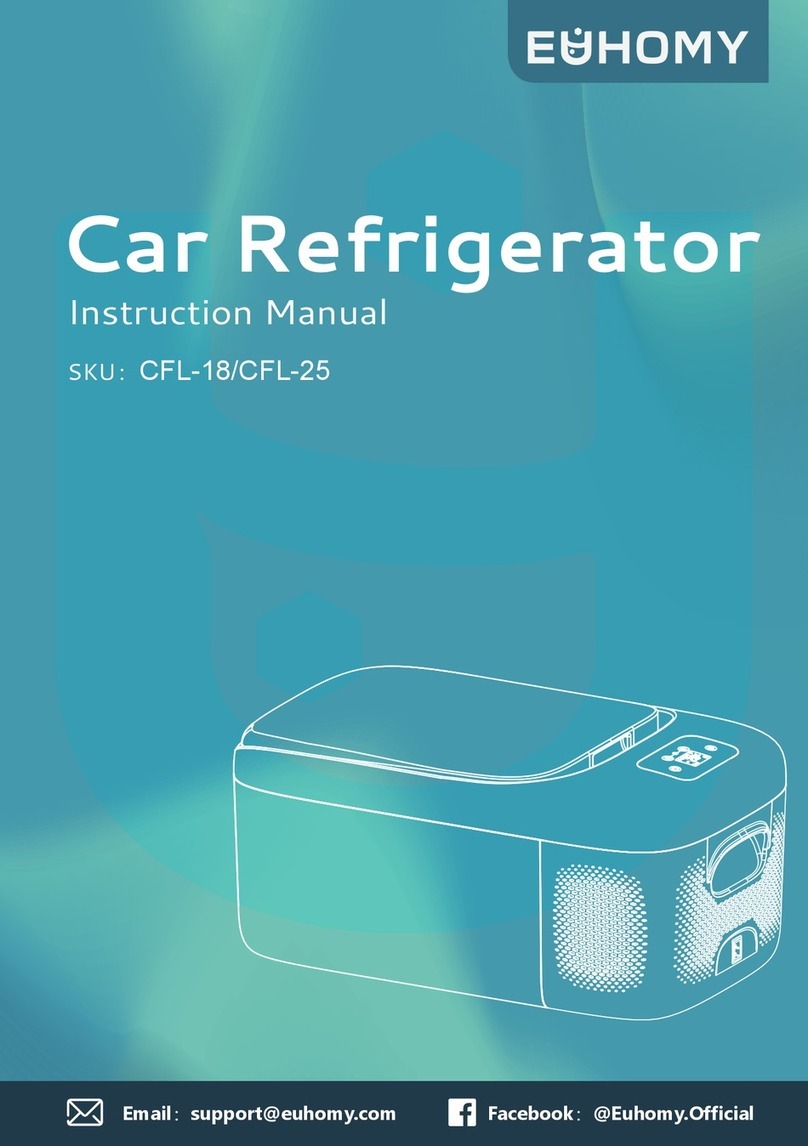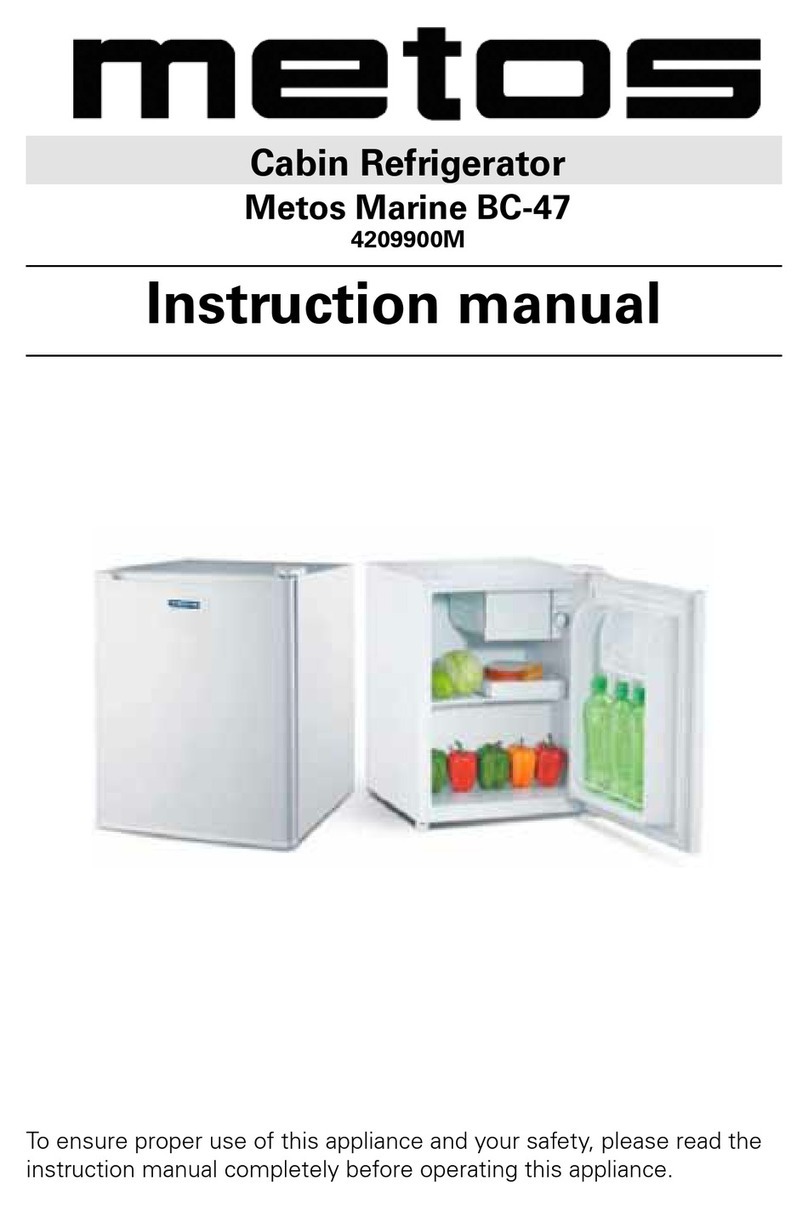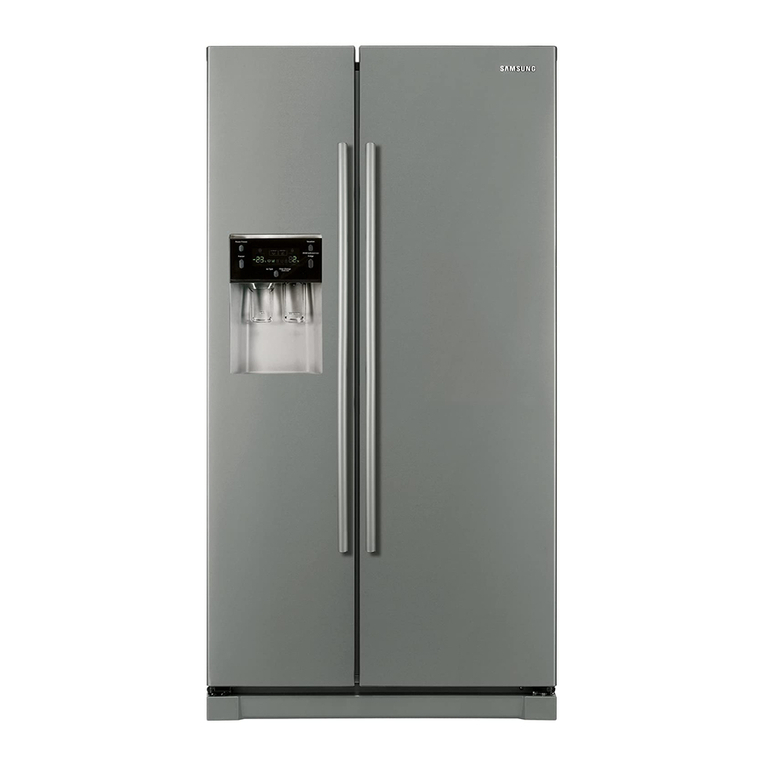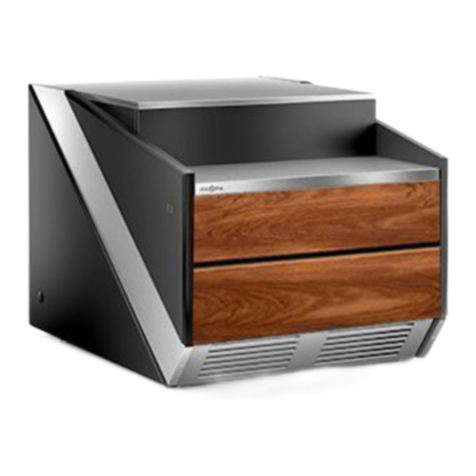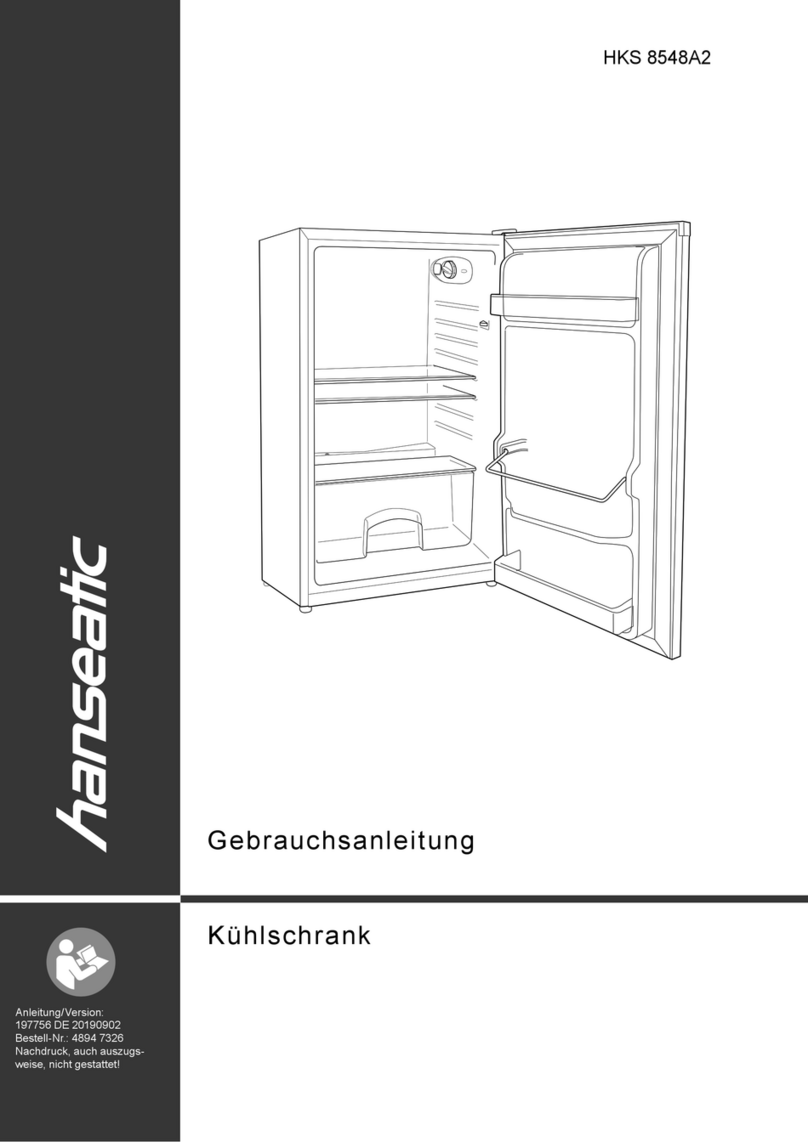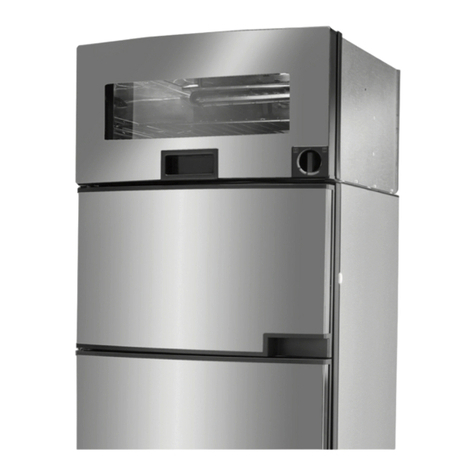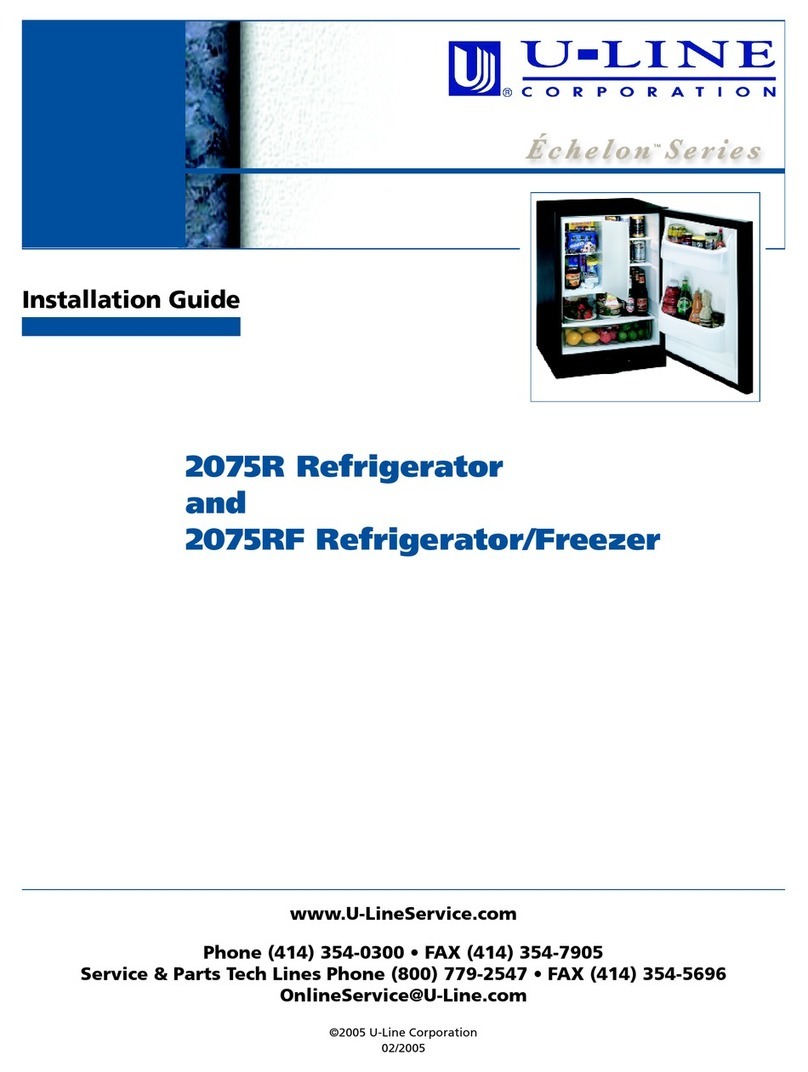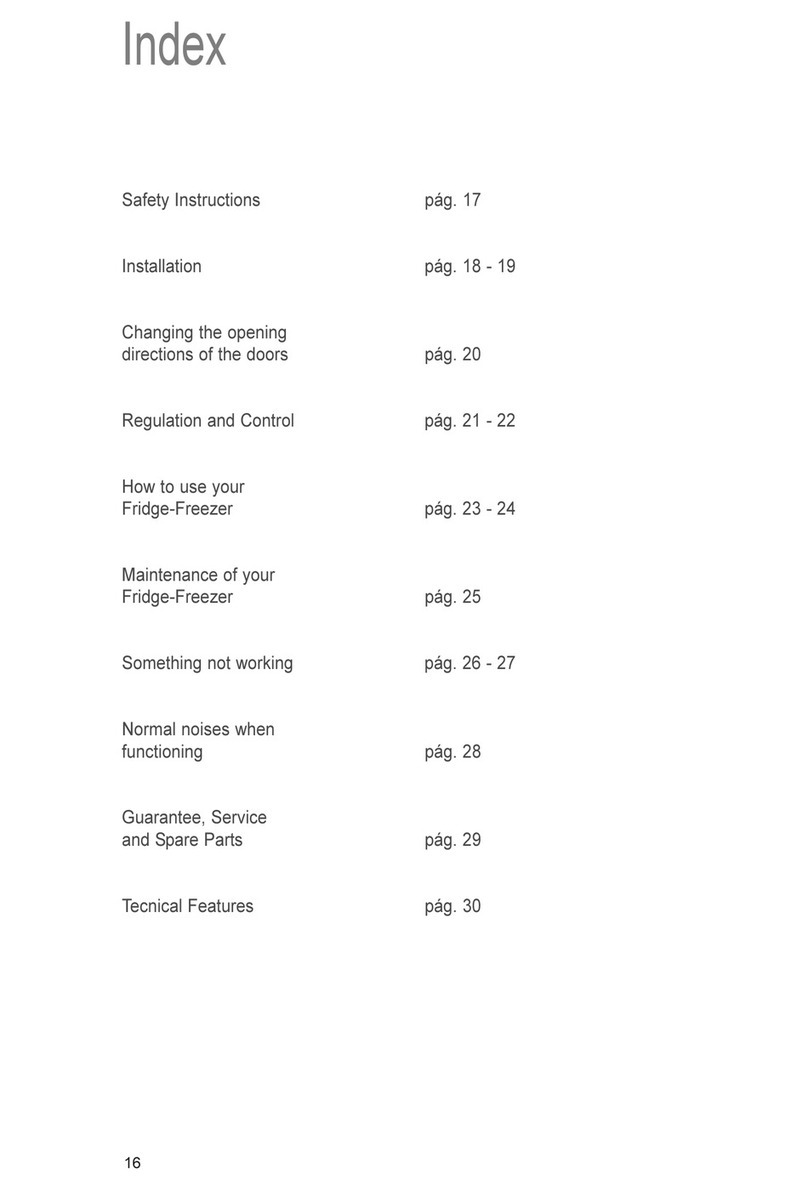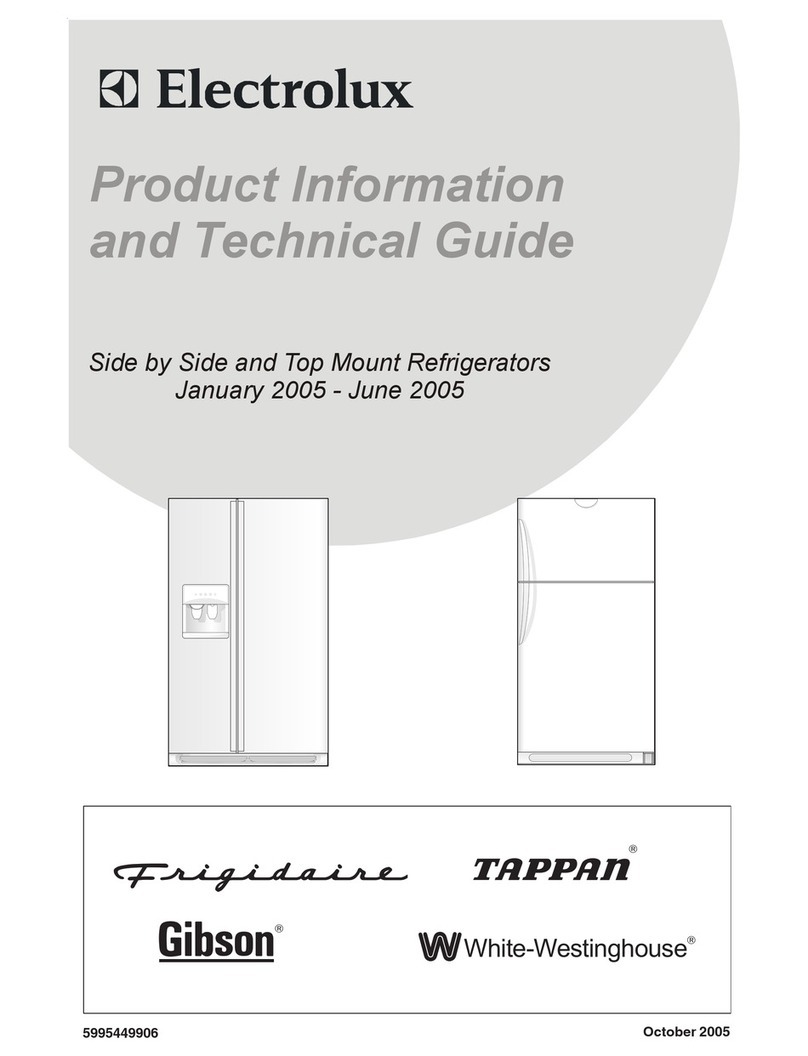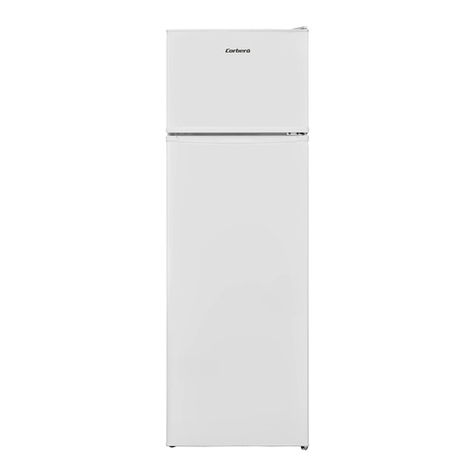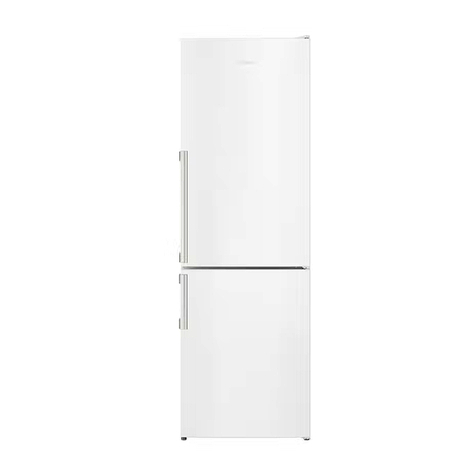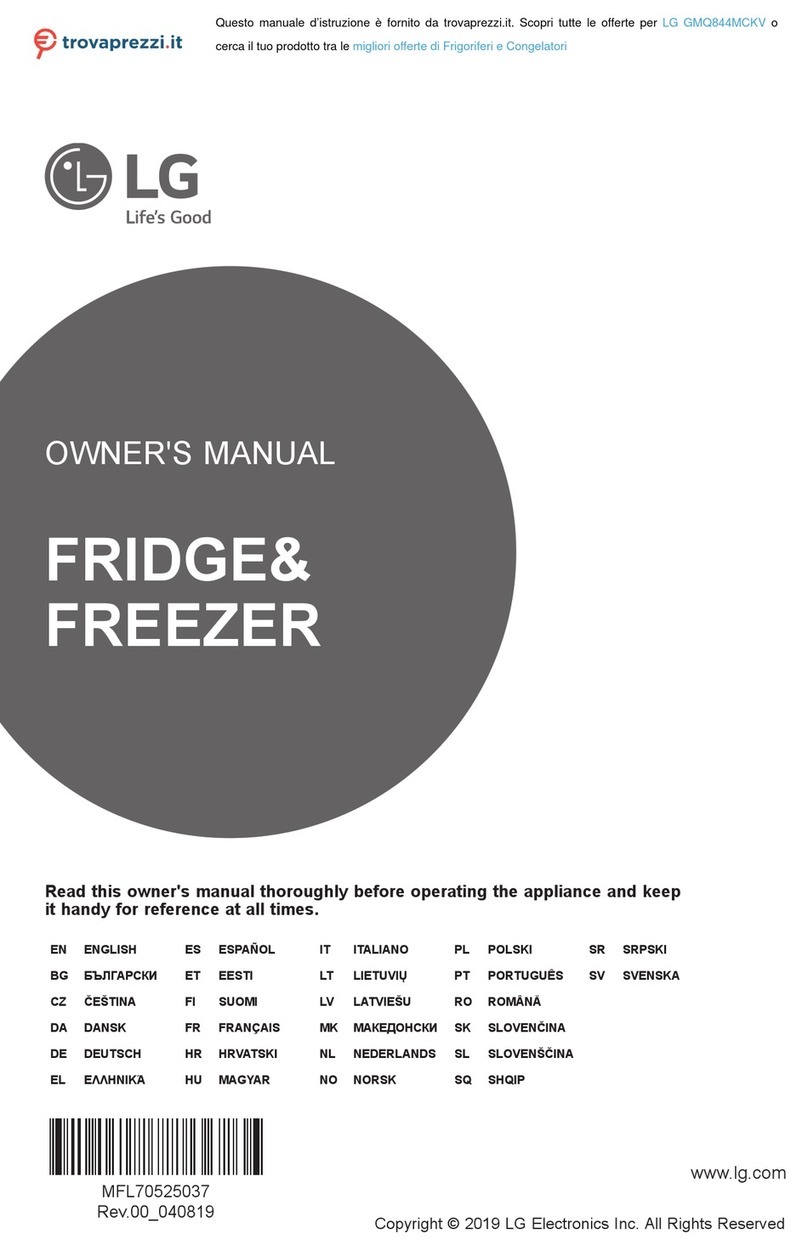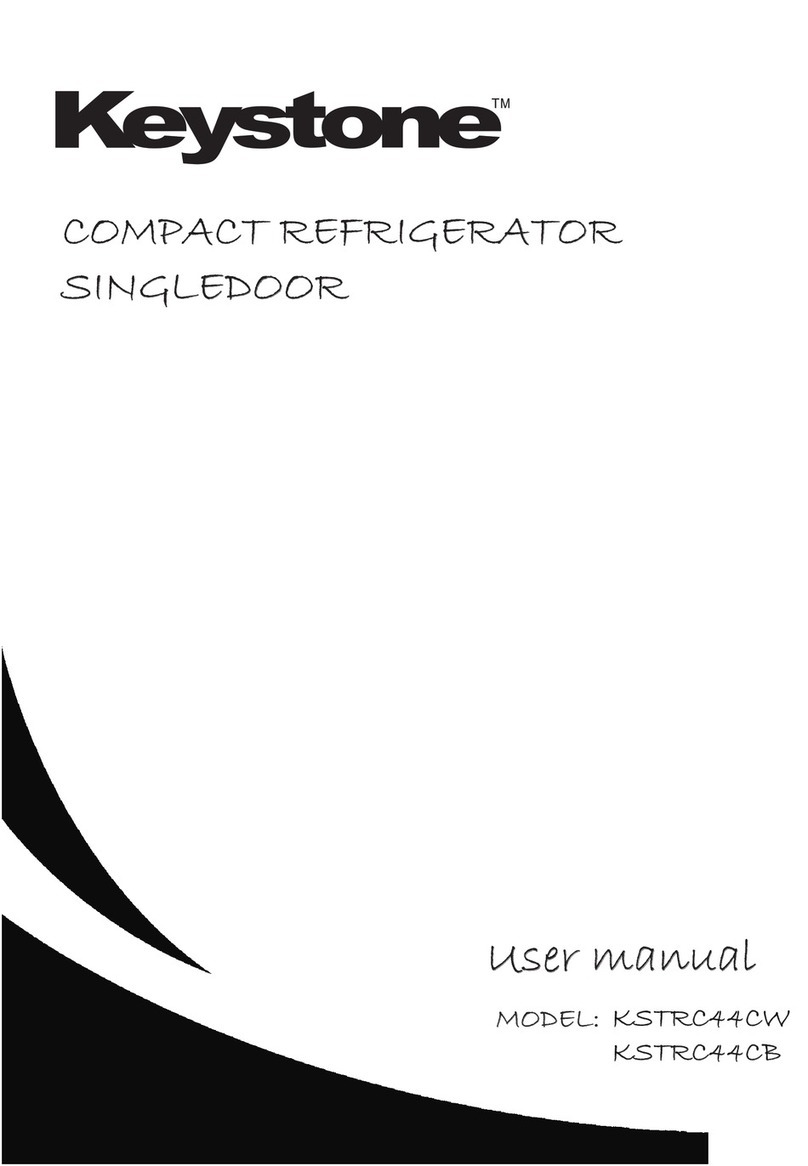Shomar P873MDBI User manual

Built In Fridge Freezer
P873MDBI
INSTRUCTIONS:
Please read and keep safe for future use.

Features…………………………….………………………………………………………………..
Transportation Instructions....................................................................
Introduction & Safety Warnings............................................................
Electrical Requirements ………………….......................................................
Installation / Door Reversal………………………………………………………………..
Food Storage……………………………............................................................
Defrosting.............................................................................................
Arrangement of Food……………….…………………………………………………………
Temperature Control .................……………………………..............................
Cleaning and care ……………………..………………….……………………….……………
Replacing the interior light bulb/Top Tips………………………….…………………
Problem Solving.......................................................................................
Health and Safety....................................................................................
Warranty Information..............................................................................
Customer Care ……………………………………………………………………………………..
Installation and User Instructions

Features

•When transporting, never tilt the appliance to more than 45 degrees.
•The appliance should be transported only in a vertical upright position
•The packaging as supplied must be intact during transportation
•If during the course of transport the appliance has to be transported
horizontally, it must only be laid on its left hand side when standing in
front of the appliance. After bringing it to the upright position, it must not
be operated for at least 4 hours to allow the system to settle. The
manufacturer will not be held responsible if these instructions are
disregarded.
•The appliance must be protected against rain and moisture
•When positioning your appliance take care not to damage your flooring,
Kitchen furniture, related parts and doors, pipes, wall coverings etc.
•Empty any water in the drain tray before moving. See section ‘Defrosting’
and ‘Care & cleaning’ for further information
•Do not move the appliance by pulling by the door
•Hold the base and lift the refrigerator carefully
•Never hold the door handle as support
•Never place the refrigerator upside down or lie it down
•Move refrigerator by using its two hind roller feet as an axis and then
tilting it slightly to move
•Make sure that the defrost water pipe at the back of the product is fixed
to the plastic evaporating pan on the top of the compressor, to avoid
defrost water spillage on the floor
Care must be taken while cleaning / carrying the appliance to avoid
Touching the bottom of the condenser metal wires at the back of the
Appliance as you might injure your fingers and hands.
Transportation of your Appliance

IMPORTANT! DO NOT connect your appliance to the electricity supply until all
Packing and transit protectors have been removed.
•Leave to stand for at least 4 hours before switching on to allow
compressor oil to settle if transported horizontally
•If you are discarding an old refrigerator with a lock fitted to the door,
disable the lock, ensure that it is left in a safe condition to prevent the
entrapment of young children
•This fridge/freezer must only be used for its intended purpose i.e. the
storing and freezing of edible foodstuff
•Do not dispose of the appliance on a fire
•Take care not to damage the cooling circuit, if damaged immediately
ventilate the room where the appliance is situated and ensure there is no
exposure to a naked flame
•This appliance should not be used in an unheated, cold room i.e. Garage,
conservatory, annex, shed, out-house etc.
•Ensure that the plug remains readily accessible
•Failure to observe these instructions may invalidate your right to free
service during the guarantee period
•We recommend a separate switch be used to ensure easy switch on / off
•Children should be supervised to ensure that they do not play with the
appliance
•This appliance is intended to be used in a household environment
•Do not use mechanical devices or other means to accelerate the
defrosting process
Before First Use

IMPORTANT WARNING:
Keep ventilation openings in the appliance enclosure and the built-in
structure clear of obstruction.
Make sure that mains cable is not caught under the appliance during
and after carrying / moving the appliance, to avoid the mains cable
becoming cut or damaged.
Before you insert the plug into the wall socket make sure that the voltage and
The frequency shown in the rating plate inside the appliance corresponds to
Your electricity supply. We recommend that this appliance is connected to the
mains supply via a suitable switched and fused socket in a readily accessible
position.
Should the mains lead of the appliance become damaged or should it need
Replacing at any time, it must be replaced by a special purpose made mains
Lead which can only be obtained from Shomar Ltd.
WARNING! THIS APPLIANCE MUST BE EARTHED
If the fitted plug is not suitable for your socket, then the plug should be removed
and an appropriate plug fitted. Destroy the old plug which is cut off as a plug with
bared cord could cause a shock hazard if inserted into a socket. The plug on this
appliance incorporates a 13 A fuse. Should the fuse need to be a fuse of the same
rating must be used. Ensure that the fuse cover is refitted.
Electrical Requirements

1. Install the refrigerator on a flat surface in order to prevent vibration and
noise.
2. Choose a dry well-ventilated place. A space of no less than 10 cm must be
left around the refrigerator.
3. The minimum space in the room where the refrigerator is being installed
is 10 cubic metres.
4. This fridge freezer has been designed to operate in ambient temperatures
Of between +5 and +32 degrees C
5. Choose a location where there is no heat source. Keep the refrigerator
away from direct sunlight, oven etc.
6. Once the appliance is in place adjust the levelling feet at the front by
turning them.
7. Do not place the appliance near cookers, radiators or in direct sunlight as
This will cause your appliance to work harder. . If installed next to a
source of heat or freezer, maintain the following minimum side
clearances:
From Cookers 50 mm
From Radiators 300 mm
From Freezers 25 mm
Installation Instructions

Minimum space underneath refrigerator 200 cm ²
8. Ensure that there is sufficient ventilation and that the cabinet is of
adequate size.
9. Slowly and carefully push the appliance inside the cabinet.
10. Push the appliance into the cabinet and adjust it to make sure the
edge on the top baffle completely touches the top edge of the
cabinet and the limit hook for the supporting leg completely
touches the bottom edge of the cabinet.
11. Fix the supporting leg with screws also fix the Top baffle to the top of the
inner cabinet screw to secure and cover with Screw caps.

12. Open the lower door of the cabinet to maximum angle than open the
lower freezer door to the corresponding position. Slide the block into
position and ensure inner edge aligns with the lower edge of the
refrigerator door than fix the block door screw and cover with screw caps.
Fix Upper refrigerator door to the cabinet door in the same way
13. Take out Sealing Strip from accessory bag and press in the gap
between the cabinet and the refrigerator.
Installation is complete.

Tools Required
Philips screwdriver
Putty Knife
Flathead screwdriver
5/16’’ socket & ratchet
Masking Tape
1. Power off the appliance and remove all items from door trays
2. Remove the upper hinge and the hole cap
3. Remove the refrigerator door and bottom hinge and hole cover
4. Exchange the bottom right hinge and upper right hinge, then install
them according to below steps and re install the top hole cap on the
opposite side.
5. Remove the two fixed blocks from the refrigerator door and rotate
them by 180 degree and install on the opposite side.
Door Reversal instructions

6. Remove the upper hinge from the freezer door
7. Remove the freezer door , the bottom hinge and hole caps
8. Exchange the bottom front hinge and upper front hinge, then install
them according to the steps below , and install the top hole cover and
lower hole caps
9. Remove the two fixed blocks from the freezer door and rotate them by
180 degree and install then on the other side of freezer door
Before you start using the fridge check that:
1. The interior is dry and air can circulate freely at the rear of the cabinet.
2. Clean the interior as recommended under "Cleaning and Care."
3. Insert the plug into the wall socket and switch on the electricity supply.
4. You will hear a noise as the compressor starts up. The liquid and gases
sealed within the refrigeration system may also give rise to noise,
whether the compressor is running or not which is quite normal.
5. When the door is open the fridge interior light will come on.
6. Front edges of the cabinet may feel warm. This is normal.
7. Do not load the appliance immediately it is switched on. Wait until the
Correct storage temperature has been reached. We recommend that you

Check the temperature with an accurate thermometer and wait 24 hours
Before placing food in the fridge or freezer
NOTE: If it is a requirement that the freezer door is to be reversed please
contact our customer services department for further information (see contact
details below)
How to Use the Refrigerator Compartment:
•Cooked/fresh foods may be stored in your refrigerator. Hot foods must
first be allowed to reach room temperature before storage
•Eggs and bottle’s should be stored on the shelves provided in the door
•Meat and fish should be covered to prevent loss of moisture and odours
wrap such foods in aluminium foil or polythene or store in an airtight
container
•It is advisable to store cooked food on top shelves and fresh food on the
lower shelves to prevent cross contamination
How to Use the Freezer Compartment:
•Pre-packed commercially frozen food should be stored in accordance with
the frozen food manufacturer's instructions for a frozen food storage
compartment
•To ensure that the high quality achieved by the frozen food manufacturer
and the food retailer is maintained, the following should be observed:
- Put packets in the freezer as quickly as possible after purchase.
- Ensure that contents are labelled and dated.
- Do not exceed "Use By" or "Best Before" dates on the packaging.
•If there is a power failure do not open the door. Frozen food should not
be affected if the failure lasts for less than 14 hrs. If the failure is longer,
then the food should be checked and either eaten immediately or cooked
and then refrozen.
Food Storage

Freezing Fresh Food:
•Do not freeze too large a quantity at any one time. The quality of the food
is best preserved when it is frozen right through as quickly as possible
•Do not exceed the freezing capacity of your appliance in 24 h which is 4 kg
(9 lb)
•Placing warm food into the freezer compartment causes the refrigeration
compressor to operate continuously until the food is frozen solid. This can
temporarily lead to excessive cooling of the refrigeration compartment
•It is possible to “Quick freeze” by selecting Super Mode
MAKING ICE CUBES
•Fill the ice - cube tray 3/4 full with water
•Loosen frozen trays with the handle of a spoon, never use sharp edged
objects such as knives, forks.
DEFROSTING THE REFRIGERATOR
The fridge compartment defrosts automatically. The defrosting water runs
To the drain tube via a collection container at the back of the appliance. During
defrosting water droplets may form at the back of the fridge compartment where
the concealed evaporator is located. Some droplets may remain on the liner and
refreeze when defrosting is completed. Do not use pointed or sharp edged objects
such as knives, forks to remove the droplets which have frozen. If at any time the
defrost water does not drain from the collection channel, check to ensure that no
food particles have blocked the drain tube. The drain tube can be cleared
manually.
In case of a temporary ice build- up in the fridge compartment, reduce the
Thermostat setting to 1, monitoring at the same time that the fridge temperature
Defrosting

Is maximum +5 degrees C [41 degrees F] once the ice build-up disappear
And the appliance starts auto defrosting again as normal, then you may increase
The thermostat setting, if required.
DEFROSTINGTHE FREEZER COMPARTMENT
Switch off the appliance and pull out the mains plug. Remove and wrap all food
and store in a cool place, ideally another freezer. Remove all drawers. Containers
of warm water may be placed in the freezer to speed up the process. Never use
sharp objects to scrape off ice. Never use electrical items such as hairdryers or
heaters to melt the ice. When ice has melted sponge out any water which collects
at the bottom of the freezer and dry thoroughly. Insert plug and turn on
appliance.
WARNINGS!
The fan inside the freezer compartment circulates cold air.
Never insert any object through the guard.
Do not allow children to play with the freezer fan.
Never store products that contain inflammable propellant gas (e.g. dispensers,
spray cans etc.) or explosive substances.
Don’t cover the shelves with any protective materials, which may obstruct air
Circulation.
WARNINGS!
Do not allow children to play with the appliance or tamper with the controls.
Do not obstruct the freezer fan guard to ensure that you obtain the best
possible performance from your appliance.
Do not use any other heated electrical appliance to speed up the defrosting
process.

The following are guidelines to obtain the best results:
1. The fridge compartment is for the short term storage of fresh food and
drinks.
2. The freezer compartment is rated and suitable for the freezing and
storage of pre frozen food. The recommendation for storage as stated on
the food packaging should be observed at all times.
3. Cooked dishes must be stored in airtight covered containers.
4. Fresh wrapped produce can be placed on the shelf. Fresh fruit and
vegetables should be cleaned and stored in the crisper bins.
5. Bottles can be placed in the door section.
6. To store raw meat, wrap in polythene bags and place on the lowest shelf.
Do not allow to come into contact with cooked food to avoid
contamination. For safety, only store raw meat for two to three days.
7. Keep the food packed wrapped or covered. Allow hot food and beverages
to cool before placing them in the fridge.
8. Do not store explosive substances.
9. High proof alcohol must be stored upright in sealed containers.
10. Left over canned food should not be stored in the can.
11. Fizzy drinks should not be frozen and products such as flavoured water
ices should not be consumed too cold.
12. Some fruit and vegetables suffer damage if kept at too low a
temperature. It helps to wrap pineapples, melons, cucumbers, tomatoes
and similar produce in polythene bags.
13. Place chilled cooked food and similar food near the rear of the fridge
inner liner where the cold wall is located.
14. Shelves, racks, crisper bins, drawers are all removable.
15. Do not leave frozen food at room temperature to thaw; the best way to
defrost food is to put it in the fridge to thaw slowly.
16. For hygiene reasons, always wrap food using a suitable packaging
material before storing in your appliance to avoid contact with the
appliance surface.
Arrangement of Food in the Fridge/Freezer

Set Button
Repeatedly press to change the set temperature between 2, 4, 6 and 8
degrees. The temperature set will be shown by the illuminated number
above the button. The Fridge will start to operate at the new temperature
after a 15 second delay.
Child Lock
The Child Lock will activate if there is no input on the control panel
for 15 seconds. Press and hold the set button for 3 seconds to lock the
controls. When unlocking the display will flash for 2 seconds.
Standby Mode
With the Child Lock tuned off Press and hold the set button for 10
seconds. After the 30 second delay the fridge will enter standby mode.
To turn the fridge on press the hold and set button for 10 seconds.
Error
If a Problem is detected one of the numbers will flash to indicate the
fault
8/ Refrigerator temperature sensor circuit Press Mode button to select
6 / Refrigerator / freezer defrost sensor
2/ Ambient temperature sensor
Temperature Control

When the appliance is switched on for the first time, the setting should be
Adjusted so that after 24 hours, the average fridge temperature is no higher
Than +5 degrees Celsius. Some sections of the fridge may be cooler or warmer
(such as the salad crisper and the top part of the cabinet) which is quite normal.
The normal storage temperature of the freezer should be -18 degrees Celsius.
We recommend that you check the temperature with an accurate thermometer
To ensure that the storage compartments are kept to the desired temperature.
Each time the door is opened cold air escapes and the internal temperature rises,
therefore never leave the door open and ensure it is closed immediately after
food is put in or removed.
•Switch off the appliance at the socket outlet and pull out the mains plug
before cleaning
•Never use any sharp abrasive instrument, soap, household cleaner,
detergent and wax polish for cleaning
•Use lukewarm water to clean the cabinet of the appliance and wipe it dry
•Wipe the inside and outside of refrigerator with a damp soft cloth, a soft
cloth with a mild detergent may also be used if required.
•Make sure that no water enters the lamp housing
•Clear the defrost drain situated at the back
•Excess deposits of ice should be removed on a regular basis with the
handle of a spoon. A large accumulation of ice will impair the
performance of the appliance
•If the appliance is not going to be used for a long period of time unplug
the appliance, remove all food, clean it and leave the door ajar
•Check door seals regularly to ensure they are clean and free from food
particles
•To remove door racks, remove all the contents and then simply push the
door rack upwards from the base
•To remove a freezer drawer, pull it as far as possible, and then tilt it
upwards, and then pull it out completely
Cleaning and Care

If you are going away on holiday or for any other reason, wish to leave the
refrigerator idle for any period of time, proceed as follows:
•Disconnect the refrigerator from the electric power supply by removing
the plug from the wall socket
•Remove all food
•Clean and dry the inside
•Leave the doors open to prevent any unpleasant smells from building up
while the refrigerator is not used
Your appliance is fitted with an LED lamp which should be replaced by a
suitably qualified technician.
•Clean and defrost your appliance regularly
•Keep raw meat and poultry below cooked food and dairy products
•Take off any unusable leaves on vegetables and wipe off any soil
•Wrap cheese firstly in greaseproof paper
•Wrap raw meat and poultry loosely in polythene or aluminium foil
•Wrap fish and offal in polythene bags
•Wrap foods which have a strong odour in polythene bags, aluminium foil
or place in an airtight container
•Wrap bread well to keep it fresh
•Keep food for as short a time as possible and adhere to "Best Before/Use
by" dates
•Store commercially frozen food in accordance with the instructions given
on the packets
•Wrap frozen food when you buy it and put it in to the freezer as soon as
Possible
•Prepare fresh food for freezing in small portions to ensure rapid freezing
Replacing the Interior Light Bulb
Top Tips

•Don't store bananas or melon in your fridge compartment
•Don't store poisonous, flammable or dangerous substances in your
appliance
•Don't consume food which has been stored for an excessive time in the
fridge
•Don't leave the door open for long periods as this will make the appliance
more costly to run and cause excessive ice formation
•Don't put hot food into the appliance
•Don't put liquid-filled bottles or sealed cans containing carbonated liquids
into the freezer as they may burst
•Don't exceed the maximum freezing loads (4 kg in any 24 hours) when
freezing fresh food
•Don't give children ice-cream and water ices direct from the freezer. The
low temperature may cause 'freezer burns' on lips
•Don't freeze fizzy drinks
•Don't try to keep frozen food which has thawed, it should be eaten within
24 hours or cooked and refrozen
•Don’t leave frozen food at room temperature to thaw; put it in the fridge
to thaw slowly
•Keep electrical cable away from all sources of heat
•To maintain efficiency keep door opening to a minimum
•Keep ventilation openings clear of obstructions
•The appliance should only be used indoors and should not be exposed to
rain or moisture
•Don't place heavy objects onto the refrigerator
•Don’t remove items from the freezer while your hands are wet as it may
cause freezer burn

ENERGY SAVING TIPS
•Ensure your appliance is installed in a well-ventilated area. If the ambient
temperature is low (but in no case lower than 5 degrees C), then the
energy saving will be more
•Ensure the time between buying chilled/frozen food and placing them in
your appliance is kept at minimum, particularly in summer. We
recommend you use a cool bag or a special carrier bag to carry frozen
food
•Do not leave the door of your appliance open longer than necessary and
ensure they are closed properly after each opening
Check the following:
•That the plug is inserted properly in the socket and that the power supply
is on
•That the fuse has blown/circuit breaker has tripped/main distribution
switch has been turned off
•That the temperature control has been set correctly
•That the plug is wired correctly if you have changed the fitted plug
If the appliance is still not operating after the above checks, please contact
Shomar Ltd, see contact details.
Please ensure that the above checks have been made as a charge will be made
If no fault is found.
Working Defects and Failures
Symptom: Appliance will not work at all.
Problem Solving
Table of contents
